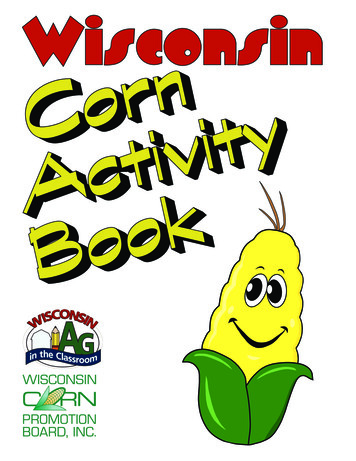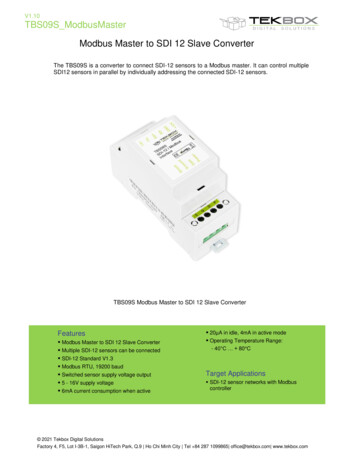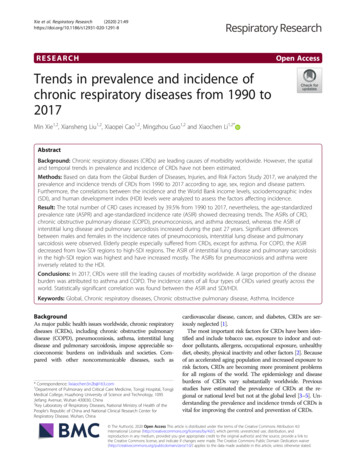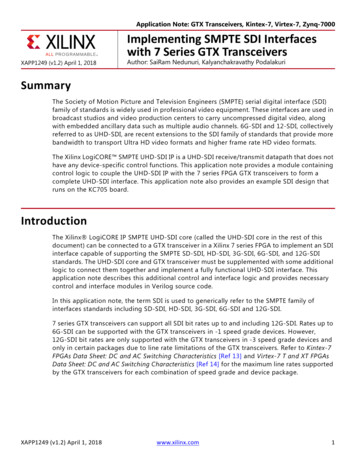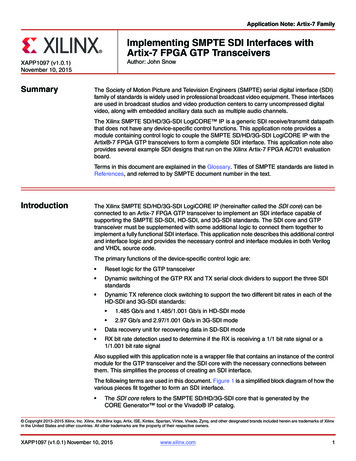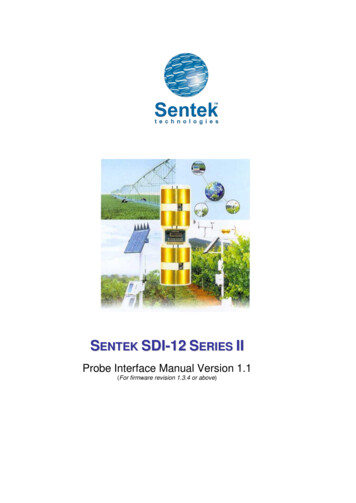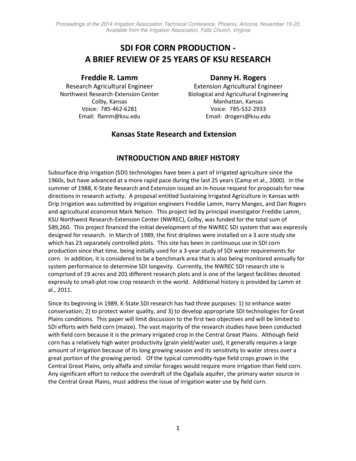
Transcription
Proceedings of the 2014 Irrigation Association Technical Conference, Phoenix, Arizona, November 19-20,Available from the Irrigation Association, Falls Church, VirginiaSDI FOR CORN PRODUCTION A BRIEF REVIEW OF 25 YEARS OF KSU RESEARCHFreddie R. LammDanny H. RogersResearch Agricultural EngineerExtension Agricultural EngineerNorthwest Research-Extension CenterColby, KansasVoice: 785-462-6281Email: flamm@ksu.eduBiological and Agricultural EngineeringManhattan, KansasVoice: 785-532-2933Email: drogers@ksu.eduKansas State Research and ExtensionINTRODUCTION AND BRIEF HISTORYSubsurface drip irrigation (SDI) technologies have been a part of irrigated agriculture since the1960s, but have advanced at a more rapid pace during the last 25 years (Camp et al., 2000). In thesummer of 1988, K-State Research and Extension issued an in-house request for proposals for newdirections in research activity. A proposal entitled Sustaining Irrigated Agriculture in Kansas withDrip Irrigation was submitted by irrigation engineers Freddie Lamm, Harry Manges, and Dan Rogersand agricultural economist Mark Nelson. This project led by principal investigator Freddie Lamm,KSU Northwest Research-Extension Center (NWREC), Colby, was funded for the total sum of 89,260. This project financed the initial development of the NWREC SDI system that was expresslydesigned for research. In March of 1989, the first driplines were installed on a 3 acre study sitewhich has 23 separately controlled plots. This site has been in continuous use in SDI cornproduction since that time, being initially used for a 3-year study of SDI water requirements forcorn. In addition, it is considered to be a benchmark area that is also being monitored annually forsystem performance to determine SDI longevity. Currently, the NWREC SDI research site iscomprised of 19 acres and 201 different research plots and is one of the largest facilities devotedexpressly to small-plot row crop research in the world. Additional history is provided by Lamm etal., 2011.Since its beginning in 1989, K-State SDI research has had three purposes: 1) to enhance waterconservation; 2) to protect water quality, and 3) to develop appropriate SDI technologies for GreatPlains conditions. This paper will limit discussion to the first two objectives and will be limited toSDI efforts with field corn (maize). The vast majority of the research studies have been conductedwith field corn because it is the primary irrigated crop in the Central Great Plains. Although fieldcorn has a relatively high water productivity (grain yield/water use), it generally requires a largeamount of irrigation because of its long growing season and its sensitivity to water stress over agreat portion of the growing period. Of the typical commodity-type field crops grown in theCentral Great Plains, only alfalfa and similar forages would require more irrigation than field corn.Any significant effort to reduce the overdraft of the Ogallala aquifer, the primary water source inthe Central Great Plains, must address the issue of irrigation water use by field corn.1
CONSERVING WATER AND/OR INCREASING CROPWATER PRODUCTIVITY WITH SDI SYSTEMSWATER CONSERVATION CONCEPTS WITH SDIWhen properly managed, there is no need for any type of irrigation system to waste water. Using asimilar train of thought, no irrigation system can save water. Only a human action or decision canactually save water. Howell and Evett (2005) correctly point out that difficulties can arise ifincompatible temporal and spatial scales are used in statements about effective water use. Forexample, water savings from a reduction in deep percolation may be inconsequential if thetemporal scale is large enough to allow return to the aquifer. Similarly, reduction of runoff is not awater savings on a large spatial scale when the runoff can be reused at a downstream location inthe basin. The debate over the proper use of water conservation terms has and will continue to bethe topic of many publications and presentations. Rather than go into this debate any further,discussion here will be limited to improvements in water usage at the farm level that can beobtained on a real-time basis. This temporal and spatial scale is highly relevant to the farmer in aneconomic sense, but is also relevant to society through stabilization of farm income and through itsmultiplying effect in the overall economy. Whether the water is actually conserved or extended toanother beneficial use will not be the topic of this discussion.Subsurface drip irrigation (SDI) applies water below the soil surface to the crop root zone throughsmall emission points (emitters) that are in a series of plastic lines typically spaced betweenalternate pairs of crop rows (Figure 1). This method of irrigation can be used for small, frequent,just-in-time irrigation applications directly to crop root system.Figure 1. Alternate row/bed 5 ft SDI dripline spacing for corn rows spaced at 2.5 ft. Each plant rowis approximately 1.25 ft from the nearest dripline and has equal opportunity to theapplied water.2
The primary ways that SDI can potentially increase crop water productivity and/or save water are: Reduction and/or elimination of deep drainage, irrigation runoff, and water evaporation Improved infiltration, storage, and use of precipitation Improved in-field uniformity and targeting of water within plant root zone Improved crop health, growth, yield, and quality.GENERAL EFFECT OF IRRIGATION LEVEL ON CORN YIELDS AND WATER PRODUCTIVITYRelative corn yieldThe results from four SDI studies on corn water use were summarized by Lamm, 2005. Relativecorn yield reached a plateau region at about 80% of full irrigation and continued to remain at thatlevel to about 130% of full irrigation (Figure 2). Yield variation as calculated from the regressionequation for this plateau region is less than 5% and would not be considered significantly different.The similarity of results for all four studies is encouraging because the later studies included theeffect of the four extreme drought years of 2000 through 2003. An examination of waterproductivity (WP) for the same four studies indicates that water productivity plateaus for levels ofirrigation ranging from 61% to 109% of full irrigation with less than 5% variation in WP (Figure 3).The greatest WP occurs at an irrigation level of approximately 82% of full irrigation. This valueagrees with results summarized by Howell, (2001) for multiple types of irrigation systems.1.00.90.80.7RYield 0.53 0.825 FFI - 0.377 FFI2RSQUARE 0.49SE 0.150.6SDISDISDISDI0.50.40.30.00.20.4Water Requirement, 1989-1991Fertilizer, 1990-1991 (Standard Fertilizer Trt)Irrigation Capacity, 1996-2001 (Hi Population Trt)Frequency, 2002-2004 (Hi Population Trt)0.60.81.01.21.4Fraction of full irrigationFigure 2. Relative corn grain yield for a given SDI research study and year as related to the fractionof full irrigation, KSU Northwest Research-Extension Center, Colby, Kansas.1.0Relative WP0.90.8RWP 0.72 0.588 FFI - 0.346 FFI20.7RSQUARE 0.27SE 0.140.6SDISDISDISDI0.50.40.30.00.20.4Water Requirement, 1989-1991Fertilizer, 1990-1991 (Standard Fertilizer Trt)Irrigation Capacity, 1996-2001 (Hi Population Trt)Frequency, 2002-2004 (Hi Population Trt)0.60.81.01.21.4Fraction of full irrigationFigure 3. Relative water use productivity (WP) of corn for a given SDI research study and year asrelated to the fraction of full irrigation, Colby, Kansas.3
The greatest WP (82% of full irrigation) also occurred in the plateau region of greatest corn yield(80 to 130% of full irrigation). This suggests that both water- and economically-efficient productioncan be obtained with SDI levels of approximately 80% of full irrigation across a wide range ofweather conditions on the soils in this region. Some of the stability in corn yield and waterproductivity across this range of irrigation levels may be explained by how deep percolation ismanaged and by how soil water is “mined” with SDI on this soil type and in this climatic region.These aspects are discussed in the next two sections.MINIMIZATION OF DEEP PERCOLATION WITH SDIDeep percolation can occur with SDI if design and management considerations such as soilcharacteristics, dripline spacing, dripline depth, and irrigation levels are not taken into account inoperational strategies (Darusman et al., 1997 a and b; and Lamm and Trooien, 2003). However,with proper management deep percolation can be minimized with SDI. Appreciable reductions indeep percolation (7% of full irrigation amount) were obtained by Lamm et al., (1995) when the cornirrigation level was reduced to approximately 74% of full irrigation with SDI without affecting actualcorn water use (Figure 4). That is, corn water needs were more closely matched with smaller andtimelier irrigation events.Water Amount (inches)30SDI Corn, Colby, KS. 5No IrrIrrigation Trt (Percent of ET)Figure 4. Calculated evapotranspiration (AET) and seasonal drainage as related to irrigationtreatment in a SDI water requirement study, Colby, Kansas, 1989-1991.“MINING” OF SOIL WATER WITH SDIIn a study from 1997 through 2000, corn was grown with SDI under 6 different irrigation capacities(0, 0.10, 0.13, 0.17, 0.20 or 0.25 inches/day) and 4 different plant populations (33100 29,900,26800, or 23700 plants/acre). The study (Lamm and Trooien, 2001) indicated even small amountsof daily SDI can benefit corn production. Daily in-season application amounts of 0.10 inches/dayresulted in corn yields of 253, 263, 236, and 201 bu/acre for the largest plant population in 1997,1998, 1999, and 2000, respectively. Even in the extreme drought year of 2000, the 0.10 inches/daycapacity resulted in corn yields twice that of the non-irrigated treatment and 78% of the maximumyield (Figure 5).4
1.019970.90.8Seasonal precipitation, 12.32 in.0.7Maximum corn yield, 270.6 elative yieldRelative yield1.00.8Maximum corn yield, 304.1 .000.050.100.150.200.250.00Irrigation capacity (inches/day)1.019990.90.8Seasonal precipitation, 16.93 in.0.7Maximum corn yield, 253.2 .050.100.150.200.25Irrigation capacity (inches/day)Relative yieldRelative yieldSeasonal precipitation, 12.69 in.0.70.40.31.019980.920000.90.8Seasonal precipitation, 6.21 in.0.7Maximum corn yield, 257.5 /a0.30.000.050.100.150.200.250.00Irrigation capacity (inches/day)0.050.100.150.200.25Irrigation capacity (inches/day)Figure 5. Relative corn grain yield as affected by daily SDI capacity and plant population. Note:Each annual panel indicates seasonal precipitation and maximum corn grain yield.Examination of soil water profiles under these SDI capacities shows some distinctive grouping ofadequately and inadequately irrigated treatments (Figure6). A possible rationale to explain thegrouping is that the upper three treatments may group together because the range of 0.17 to 0.25inches/day is sufficient to provide a large enough portion of the daily soil water needs. Even in thedrier years, there are a few opportunities to shut off irrigation for the 0.20 - 0.25 inches/daytreatments. This would allow these treatments to be closer to the effective value of 0.17inches/day, which is a capacity sufficient to reach the yield plateaus shown in Figure 5. The 0.25inches/day irrigation capacity is approximately the long term full irrigation requirement fornorthwest Kansas for corn using other irrigation methods. The higher efficiency, daily irrigationmay allow the SDI to be more effective than other irrigation methods.The lower three treatment may group together for almost the opposite reason. Available soil waterreserves become depleted to a large extent and the corn crop begins to shut-down plant processesthat use water. This shut-down tends to reduce grain yields depending on the severity and length ofthe water stress period. The fact that the 0.10 and 0.13 inches/day treatments obtain respectablecorn yield increases over the nonirrigated control may be a good indication of how well thisbalancing of water use/water conservation is being handled by the daily infusion of at least someirrigation water. The grouping of the upper three treatments suggests that an irrigation capacity of0.17 inches/day might be an adequate irrigation capacity if the producer has the desire to allocatewater to an optimum land area. It should be noted that this limited irrigation capacity would notbe sufficient on coarser-textured sandy soils which have limited water holding capacity.5
16ASW (inches/8 ft)ASW (inches/8 ft)161414121210100.25 in/day0.20 in/day0.17 in/day0.13 in/day0.10 in/dayNo irrigation864SDI Irrigation Capac ity , 1997Plant Population, 34,500 p/a20.25 in/day0.20 in/day0.17 in/day0.13 in/day0.10 in/dayNo irrigation864Plant Population, 34,600 p/a2130150170190210230250270130150170Day of year14190210230250270Day of year16SDI Irrigation Capac ity , 1999ASW (inches/8 ft)ASW (inches/8 ft)16SDI Irrigation Capac ity , 1998Plant Population, 31,000 p/aSDI Irrigation Capac ity , 20001412Plant Population, 32,400 p/a1210100.25 in/day0.20 in/day0.17 in/day0.13 in/day0.10 in/dayNo irrigation86480.25 in/day0.20 in/day0.17 in/day0.13 in/day0.10 in/dayNo irrigation6422130150170190210230250130270Day of year150170190210230250270Day of yearFigure 6. Progression of the available soil water in an 8 ft. profile as affected by daily SDI capacityfor the highest plant population treatment.Does SDI really increase crop per drop?There is growing evidence from our K-State studies (Figure 7) and others in the Great Plains that SDIcan stabilize yields at a greater level than alternative irrigation systems when deficit irrigated(Lamm et al., 2012).275Corn yield (bu/acre)250KSU-NWRECColby, Kansas225200175150125Incanopy sprinkler, 1996-1999 (Wet years)Incanopy sprinkler, 2000-2001 (Dry years)Subsurface drip, 1996-1999 (Wet years)Subsurface drip, 2000-2001 (Dry years)100750.000.050.100.150.200.25Irrigation capacity (inches/day)Figure 7. Corn yields for SDI and incanopy sprinkler irrigation in wet years and dry years at Colby,Kansas. Note: Results are from different but similar studies, so these are not statisticaldifferences.6
Although we believe this is true for most crop years, we have found that SDI sometimesexperiences some reduction in kernel set in extremely dry years (Lamm, 2004). Research iscontinuing to examine this issue in search of a solution.PROTECTING WATER QUALITY WITH SDI SYSTEMSProperly designed SDI systems have a high degree of uniformity and can apply small frequentirrigation applications, and provide an excellent opportunity to better manage nitrogen fertilizationwith these systems. Injecting small amounts of nitrogen solution into the irrigation water canspoon-feed the crop just-in-time (i.e., nearer the point of actual crop need), while minimizing thepool of nitrogen in the soil that could be available for percolation into the groundwater.COMPARISON OF PRE-PLANT BROADCAST APPLIED NITROGEN AND SDI FERTIGATIONIn an early study at Colby, 1990-1991, results indicated that nitrogen applied with SDI redistributeddifferently in the soil profile than surface-applied preplant N (Lamm et al., 2001). Although cornyields were similar between the two fertilization methods, there was greater residual soil-N for theSDI fertigation (Figure 8).0-2Depth (ft)-4Preplant Surface Applied NMay 1990, initial conditionsOct 1990, after 220 lb/aOct 1991, after 440 lb/a-6-80-2-4SDI Injected NMay 1990, initial conditionsOct 1990, after 250 lb/aOct 1991, after 460 lb/a-6-80510152025303540Nitrate Concentration (ppm)Figure 8. Nitrate concentrations in the soil profile for preplant surface-applied and SDI injectednitrogen treatments, KSU Northwest Research-Extension Center, Colby, Kansas, 1990-91.Data is for selected nitrogen fertilizer rate treatments with full irrigation (100% of AET).The additional in-season fertigation allowed for healthier and more vigorous plants that werebetter able to utilize soil water. The results suggest that a large portion of the applied N could be7
delayed until weekly injections begin with the first irrigation provided there is sufficient residual soilN available for early growth. In both years, nearly all of the residual nitrate nitrogen measuredafter corn harvest was located in the upper 12 inches of the soil profile for the preplant surfaceapplied nitrogen treatments, regardless of irrigation level. In contrast, nitrate concentrationsincreased with increasing levels of nitrogen injected with SDI and migrated deeper in the soil profilewith increased irrigation (Figure 8). This lead to a study to determine if SDI fertigation N needscould be lowered and still retain excellent yields.DEVELOPMENT OF BEST MANAGEMENT PRACTICE FOR SDI N FERTIGATION OF CORNA follow-up four year study was conducted at the KSU Northwest Research-Extension Center atColby, Kansas on a deep Keith silt loam soil to develop a Best Management Practice (BMP) fornitrogen fertigation for corn using SDI (Lamm et al., 2004). Residual ammonium- and nitratenitrogen levels in the soil profile, corn yields, apparent nitrogen uptake (ANU) and waterproductivity (WP) were utilized as criteria for evaluating six different nitrogen fertigation rates, 0,80, 120, 160, 200, and 240 lbs N/a. The final BMP was a nitrogen fertigation level of 160 lbs N/awith other non-fertigation applications bringing the total applied nitrogen to approximately 190 lbsN/a (Lamm et. al., 2004). The BMP also states that irrigation is to be scheduled and limited toreplace approximately 75% of ET. Corn yield, ANU, and WP all plateaued at the same level of totalapplied nitrogen which corresponded to the 160 lbs N/a nitrogen fertigation rate (Figure 9).Average yields for the 160 lbs N/a nitrogen fertigation rate was 213 bu/a. Corn yield to ANU ratiofor the 160 lbs N/a nitrogen fertigation rate was high at 53:1 (lbs corn grain/lbs N whole plantuptake). The results emphasize that high-yielding corn production also can be environmentallysound and efficient in nutrient and water use.Total 1994 irrigation, 10.9 inchesTotal 1995 irrigation, 12.0 inchesTotal 1996 irrigation, 6.0 inches50020015010050ityUn040nerfodli epApli80.vs400eaktUp300YieldApparent Nitrogen UptakeWater Productivity120160200200240WP (lbs grain /acre-in)Yield (bu/a) & ANU (lbs N/a)250100Applied Nitrogen (lbs/acre)Figure 9. Average (1994-96) corn yield, apparent nitrogen uptake in the above-ground biomass,and water productivity as related to the total applied nitrogen (preseason amount, starterfertilizer, fertigation, and the naturally occurring N in the irrigation water). Total appliednitrogen exceeded fertigation applied nitrogen by 30 lb/acre.8
After 4 years of continuous application of the fertigation treatments (Figure 10), nitrate-N levels inthe soil were increasing and moving downward when the fertigation rate exceeded 160 lb N/a (i.e.,equivalent to 190 lbs N/a total applications from all sources).SDI Fertigation, Colby, KS. 1994-19961Nitrogen profiles at study end, 10/14/96Depth (ft)234Injected N-rate5None80 lb/a120 lb/a160 lb/a200 lb/a240 lb/a678051510202530Nitrate Concentration (ppm)Figure 10. Nitrate concentrations within the 8 ft soil profile as affected by SDI fertigation N rateafter four years of continuous application, KSU Northwest Research-Extension Center,Colby Kansas.TIMING OF NITROGEN FERTIGATION AS AFFECTED BY IRRIGATION CAPACITYA study was conducted at the KSU Northwest Research-Extension Center at Colby, Kansas in 2010and 2012 to examine subsurface drip irrigation (SDI) capacity and nitrogen fertigation timing oncorn production (Lamm and Schlegel, 2013). Targeted SDI N fertigation events at 3 specific earlyseason growth stages (V5, V9 or VT) were compared under 2 levels of irrigation (0.25 inches/day or0.25 inches/2 days). Treatment effects were evaluated in terms of corn yield components, cropwater use, and crop water productivity. Overall, corn grain yields, kernels/area, kernel mass, andwater productivity generally were numerically greater when nitrogen fertigation timing was earlierin the crop growth and development (Table 1). The greatest corn grain yield and greatest waterproductivity was obtained in 2010 by the fully irrigated treatment receiving supplement nitrogenfertigation at the V6 growth stage. The lack of supplemental nitrogen fertigation greatly reducedgrain yields and water productivity in both years. Conjunctive management of both irrigation andinseason N fertigation are important for corn production with SDI.9
Table 1. Corn yield component, biomass and water use results from a subsurface drip irrigatedcorn study as affected by irrigation capacity and nitrogen fertigation timing, KSUNorthwest Research-Extension Center, Colby Kansas, 2010 and aKernels/area,MillionKernel/acreKernelmass, mgBiomass,lb/aWateruse, inWP,lb/a-inNoneV6V9VTV6 thru 6223.3323.6623.54376657569566597V6V9VTV6 thru 624617NoneV6V9VTV6 thru 3327.8626.0927.43358499477536504V6V9VTV6 thru 609602NoneV6V9VTV6 thru 9825.5924.8725.48367578523551551V6V9VTV6 thru 616610Crop year, 20100.25 in/dMean 0.25 in/d0.25 in/2 dMean 0.25 in/2 dCrop year, 20120.25 in/dMean 0.25 in/d0.25 in/2 dMean 0.25 in/2 dMean, both years0.25 in/dMean 0.25 in/d0.25 in/2 dMean 0.25 in/2 dACHIEVING THE GOALS OFCONJUNCTIVE MANAGEMENT OF WATER AND NUTRIENTS WITH SDIWhen water and nutrients are highly managed for greatest effectiveness, there can be less marginof error. It is important that producers are diligent in observing the corn growth and developmentand in monitoring the SDI system. A couple of example cases will illustrate the need for thisdiligence.10
Under drought conditions preplant surface-applied N can become positionally unavailable to thecrop because of dry surface layers and no root exploration (Figure 11). One should immediatelyapply N through the SDI system to remedy this nitrogen deficiency when it is observed. Thepreplant nitrogen, although unavailable under these conditions, can be recovered and utilized laterin the season or by future crops once the drought ends.Water application with deeper SDI systems is largely unobserved. A problem as simple as a brokensolenoid wire on a zone water valve can prevent irrigation (Figure 12). Producers should verifythrough flowrate and pressure that the applied irrigation is reaching the target. Soil water or plantwater stress sensors can also be used to augment these observations.Figure 11. SDI corn field experiencing N stressdue to dry surface soil conditionsdespite having abundant nitrogenreserves in the soil surface layers.Figure 12. A broken solenoid wire on a zonevalve might go unobserved ifproducers do not monitor theresystem flowrate and pressure.CONCLUSIONSResearch progress has been steady since 1989. Much of K-State’s SDI research is summarized atthe website, SDI in the Great Plains at http://www.ksre.ksu.edu/sdi/. Irrigators are watching theresults of K-State closely. Some irrigators have begun to experiment with the technology and mostappear happy with the results they are obtaining. SDI can be a viable irrigation system option forcorn production, enhancing the opportunities for wise use of limited water resources and also inprotecting water quality.ACKNOWLEDGEMENTSSeveral K-State faculty members have conducted and contributed to the progress of KSU SDI corn researchover the years since 1989. These include, Freddie Lamm, Bill Spurgeon, Todd Trooien, Harry Manges, DannyRogers, Mahbub Alam, Loyd Stone, Alan Schlegel, Gary Clark, Rob Aiken, Dan O’Brien, Troy Dumler, KevinDhuyvetter, Mark Nelson, and Norm Klocke.This paper is also part of SDI technology transfer effort beginning in 2009 involvingKansas State University, Texas A&M University and the USDA-ARS and is funded by theOgallala Aquifer Program. To follow other activities of this educational effort, point yourweb browser to http://www.ksre.ksu.edu/sdi/.This paper was first presented at the Central Plains Irrigation Conference, February 2526, 2014, Burlington, Colorado.11
REFERENCESCamp, C. R., F. R. Lamm, R. G. Evans and C. J. Phene. 2000. Subsurface drip irrigation – Past, present andfuture. In: Proc. Fourth Decennial Nat’l Irrigation Symp., Nov. 14-16, 2000, Phoenix, AZ. Sponsored byASAE. pp. 363-372. Also at p/campis.htmDarusman, A. H. Khan, L. R. Stone, and F. R. Lamm. 1997a. Water flux below the root zone vs. drip-linespacing in drip irrigated corn. Soil Sci. Soc. Am. J. 61(6):1755-1760. Also available uxSpacing.pdfDarusman, A. H. Khan, L. R. Stone, W. E. Spurgeon, and F. R. Lamm. 1997b. Water flux below the root zonevs. irrigation amount in drip-irrigated corn. Agron. J. 89(3):375-379. Also available uxIrrA.pdfHowell, T. A. 2001. Enhancing water use efficiency in irrigated agriculture. Agron J. 93(2):281-289. Alsoavailable at http://www.cprl.ars.usda.gov/wmru/pdfs/howell 2001.pdfHowell, T. A. and S. R. Evett. 2005. Pathways to efficient applications. In: Proc. Central Plains IrrigationConf., Sterling, CO., Feb. 16-17, 2005. Available from CPIA, 760 N. Thompson, Colby, KS. pp. 84-98. Alsoavailable at fLamm, F. R. 2004. Comparison of SDI and Simulated LEPA Sprinkler Irrigation for Corn. In Proc. IrrigationAssn. Int’l. Irrigation Technical Conf., November 14-16, 2004, Tampa, FL. Available from Irrigation Assn.,Falls Church, VA. IA Paper No. IA04-1098. pp. 475-485. Also available 4.pdfLamm, F. R. 2005. SDI for conserving water in corn production. In Proc. ASCE-EWRI Water Congress, May 1519, 2005, Anchorage, AK. 12 pp. Also at .pdfLamm, F. R. and A. J. Schlegel. 2013. Effect of subsurface drip irrigation capacity and nitrogen fertigationtiming on corn production. ASABE paper no. 131593348. Available from ASABE, St. Joseph, MI. 10 pp.Also available at dfLamm, F. R. and T. P. Trooien. 2001. Irrigation capacity and plant population effects on corn productionusing SDI. In Proc. Irrigation Assn. Int’l. Irrigation Technical Conf., Nov. 4-6, 2001, San Antonio, TX. pp. 7380. Available from Irrigation Assn., Falls Church, VA. Also available fLamm, F. R. and T. P. Trooien. 2003. Subsurface drip irrigation for corn production: A review of 10 years ofresearch in Kansas. Irrig. Sci. 22(3-4):195-200. Also available ars.pdfLamm, F. R., A. J. Schlegel, and G. A. Clark. 2004. Development of a best management practice for nitrogenfertigation of corn using SDI. Appl. Engr in Agric. 20(2):211-220. Also available 04.pdfLamm, F. R., T. P. Trooien, H. L. Manges, and H. D. Sunderman. 2001. Nitrogen fertilization for subsurfacedrip-irrigated corn. Trans. ASAE 44(3):533-542. Also available dfLamm, F. R., H. L. Manges, L. R. Stone, A. H. Khan, and D. H. Rogers. 1995. Water requirement of subsurfacedrip-irrigated corn in northwest Kansas. Trans. ASAE 38(2):441-448. Also available q.pdfLamm, F. R., D. H. Rogers, M. Alam, D. M. O’Brien, and T. P. Trooien. 2011. Twenty-two years of SDI researchin Kansas. In: Proc. 23rd annual Central Plains Irrigation Conf., Burlington, Colorado, Feb. 22-23, 2011.Available from CPIA, 760 N. Thompson, Colby, KS. pp. 68-92. Also available DIa.pdfLamm, F.R., J. P. Bordovsky, L. J. Schwankl, G. L. Grabow, J. Enciso-Medina, R. T. Peters, P. D. Colaizzi, T. P.Trooien, and D. O, Porter. 2012. Subsurface drip irrigation: Status of the technology in 2010. Trans.ASABE 55(2): 483-491. Also Status.pdf12
SDI Fertilizer, 1990-1991 (Standard Fertilizer Trt) SDI Irrigation Capacity, 1996-2001 (Hi Population Trt) SDI Frequency, 2002-2004 (Hi Population Trt) RYield 0.53 0.825 FFI - 0.377 FFI 2 RSQUARE 0.49 SE 0.15 The primary ways that SDI can potentially increase crop water productivity and/or save water are:
